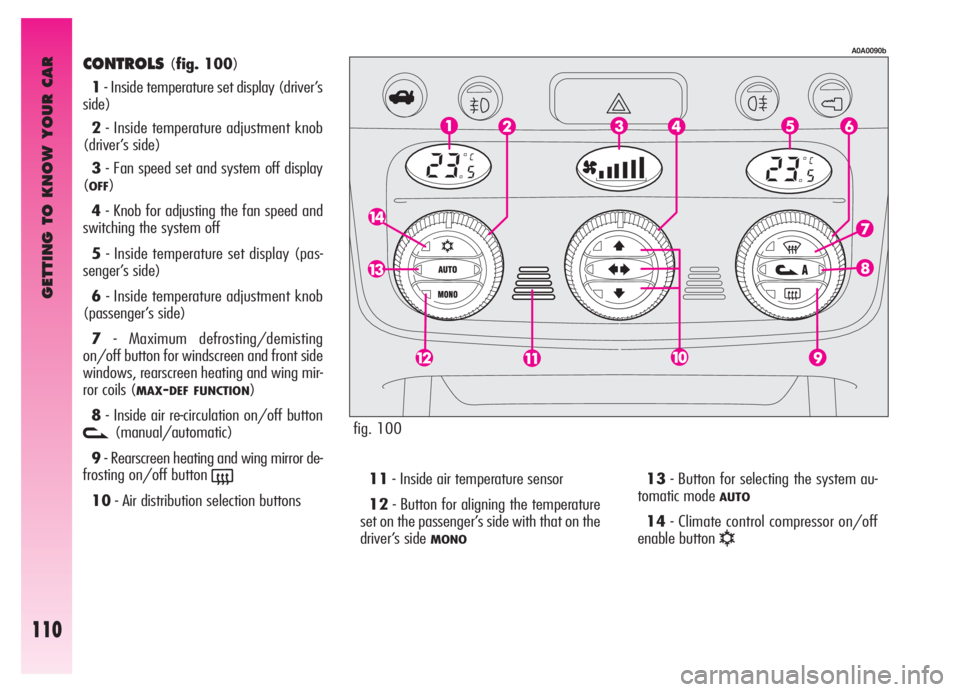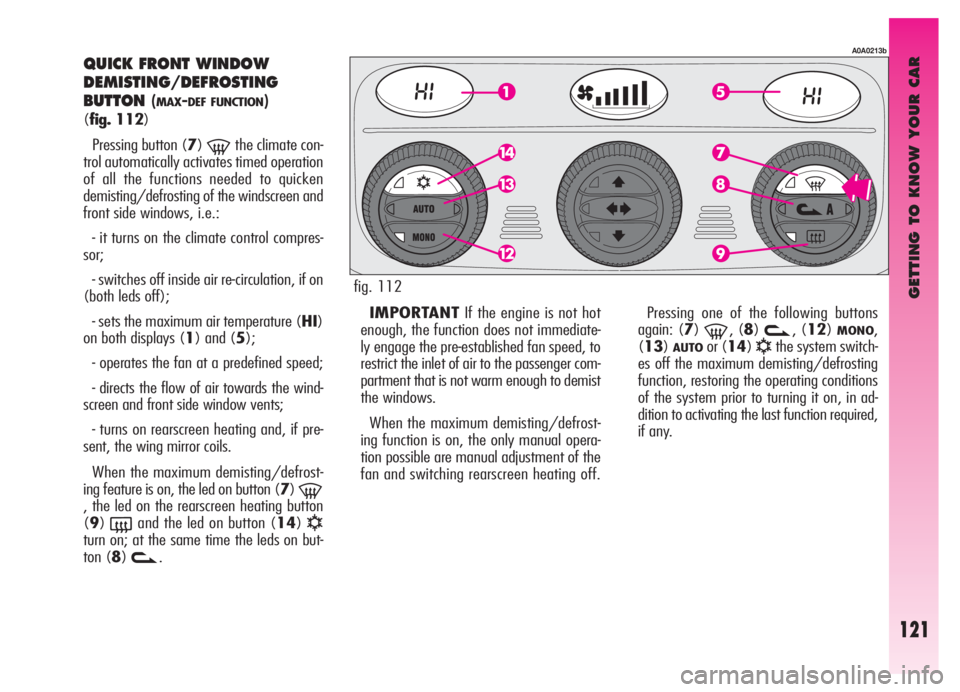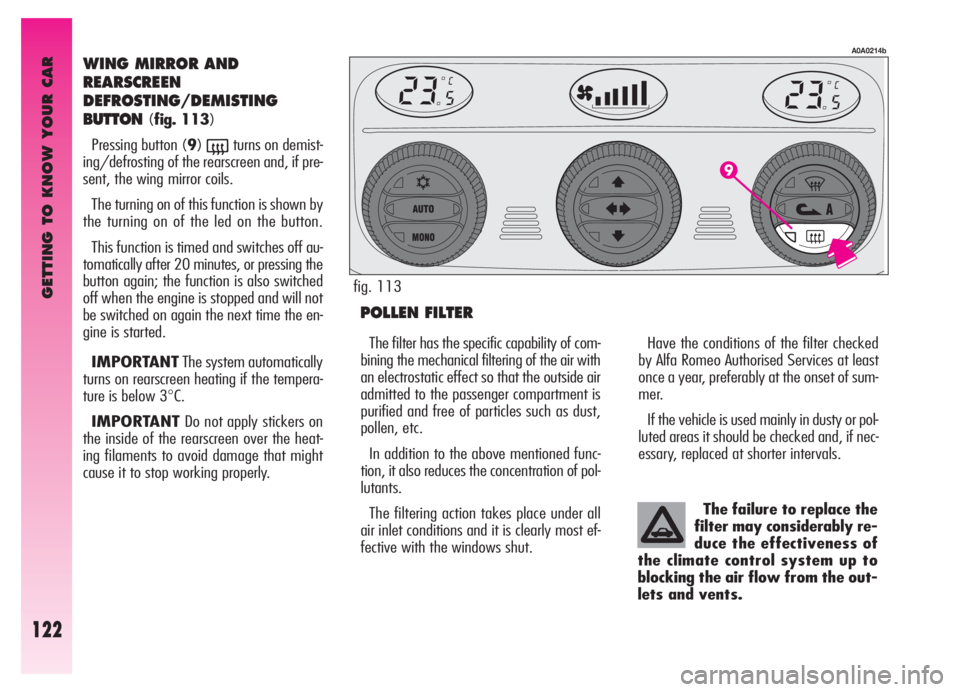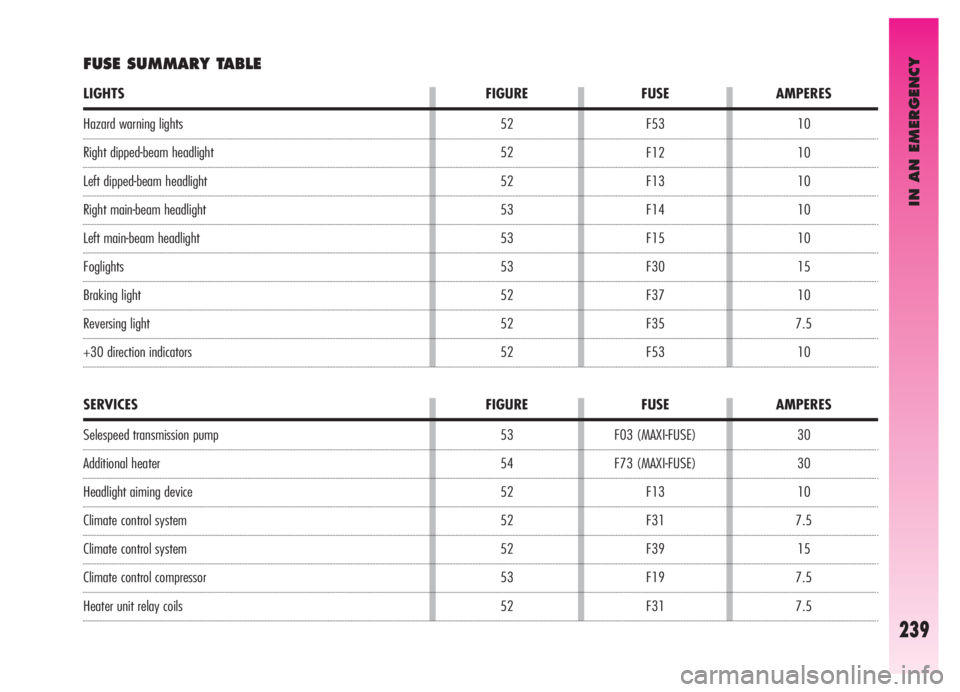climate control Alfa Romeo GT 2005 Owner handbook (in English)
[x] Cancel search | Manufacturer: ALFA ROMEO, Model Year: 2005, Model line: GT, Model: Alfa Romeo GT 2005Pages: 307, PDF Size: 6.05 MB
Page 112 of 307

GETTING TO KNOW YOUR CAR
110
CONTROLS(fig. 100)
1- Inside temperature set display (driver’s
side)
2- Inside temperature adjustment knob
(driver’s side)
3- Fan speed set and system off display
(
OFF)
4- Knob for adjusting the fan speed and
switching the system off
5- Inside temperature set display (pas-
senger’s side)
6- Inside temperature adjustment knob
(passenger’s side)
7- Maximum defrosting/demisting
on/off button for windscreen and front side
windows, rearscreen heating and wing mir-
ror coils (
MAX-DEF FUNCTION)
8- Inside air re-circulation on/off button
v(manual/automatic)
9- Rearscreen heating and wing mirror de-
frosting on/off button
(
10- Air distribution selection buttons11- Inside air temperature sensor
12- Button for aligning the temperature
set on the passenger’s side with that on the
driver’s side
MONO
13- Button for selecting the system au-
tomatic mode
AUTO
14- Climate control compressor on/off
enable button
√
fig. 100
A0A0090b
Page 113 of 307

GETTING TO KNOW YOUR CAR
111
HOW TO USE THE AUTOMATIC
TWO-ZONE CLIMATE CONTROL
SYSTEM
(fig. 100)
IMPORTANTThe knob rings do not
have a mechanical stopper therefore, once
the maximum or minimum value has been
reached, they are free to turn in both direc-
tions.
The system can be started in different
ways, but it is advisable to set the temper-
atures required on the displays; then press
the (13)
AUTObutton.
This way the system will start working
completely automatically to reach the tem-
peratures set as quickly as possible and then
maintain them.
During completely automatic system op-
eration, the temperatures set can be
changed at any time; the system will auto-
matically change its settings to adjust to the
new requirements.IMPORTANTTo be able to be accept-
ed by the system, the difference in the tem-
perature between the driver’s and passen-
ger’s side must be within a range of 7°C.
It is possible to personalise the choices
made automatically by the system inter-
vening manually on the following controls:
- fan speed adjustment knob (4)
- air distribution selection buttons (10)
- inside air re-circulation on/off button (8)v
- climate control on enable button (14)
√.
Manually selecting one or more of these
functions turns off the right led on the but-
ton (13)
AUTO.With one or more functions engaged man-
ually, the adjustment of the temperature of
the air admitted to the passenger compart-
ment continues to be controlled automati-
cally by the system (left led on button 13
AUTOon) except with the climate control
compressor off.
In fact, in this condition the air admitted
to the passenger compartment cannot have
a lower temperature than the outside air;
this condition is indicated by the turning off
of the two leds on button (13)
AUTOand
flashing on the display (1) and/or (5) re-
lated with the temperature rate that can-
not be obtained.
Page 116 of 307

GETTING TO KNOW YOUR CAR
114
LO function
(highest cooling power - fig. 103)
This is turned on setting on the display a
temperature below 16,5°C; this setting is
shown on both displays.
This function can be engaged when re-
quiring to cool the passenger compartment
as quickly as possible, exploiting the maxi-
mum potential of the system.
The function cuts off air heating, engages
inside air re-circulation (to prevent admitting
hot air to the passenger compartment) and
the climate control compressor, takes air dis-
tribution to
REand the fan speed as set
by the system.
All manual settings are possible with this
function on.
To switch the function off, simply turn the
ring of knob (2) or (6) of the temperature
set on a value above 16,5°C; the opposite
display will show 16,5°C.
Pressing key (13)
AUTOthe display will
show a temperature of 16,5°C and returns
to an operating condition with automatic
temperature adjustment.
A0A0219b
fig. 103
Page 118 of 307

GETTING TO KNOW YOUR CAR
116
FAN SPEED ADJUSTMENT
KNOB
(fig. 105-106)
Turning the ring of knob(4), clockwise or
counter-clockwise, increases or decreases
the speed of the fan, thus the amount of air
admitted to the passenger compartment;
the 16 selectable speeds are shown on a
bar (in steps of 3), up to a maximum of 6
bars lit:
- maximum fan speed = all bars lit;
- minimum fan speed = one bar lit.
The fan can be cut off (all bars off) only
if the climate control compressor has been
switched off pressing button (14)
√. To
restore automatic fan speed control, after a
manual adjustment, press button (13)
AU-
TO. Completely turning the ring of knob (4)
counter-clockwise switches the system off,
with the following situation: display (1) off;
display (5) off; centre display (3) with lit-
display
OFFand left led on inside air re-cir-
culation button (8)
von.
IMPORTANTPressing the inside air re-
circulation button (8)
vit is possible to
obtain the inlet of untreated outside air to
the passenger compartment.
To turn the system on again, simply turn
the ring of knob (4) clockwise, or press any
one button, except the inside air re-circula-
tion (8) and rearscreen (9) buttons; this
operation restores all the operating conditionsstored previously.
IMPORTANTOn leaving the
OFFcondi-
tion, inside air re-circulation
vreturns to
the condition prior to switching off.
A0A0205b
A0A0206bfig. 105
fig. 106
Page 120 of 307

GETTING TO KNOW YOUR CAR
118
press button (13)AUTO; in which case,
however, the other manual settings set will
be cancelled.
CLIMATE CONTROL
COMPRESSORON/OFF ENABLE
BUTTON
(fig. 108)
Pressing button (14)
√enables the turn-
ing on of the climate control compressor.
This condition is shown by the lighting up of
the led on the button itself.
When the climate control compressor is
turned off, the leds on buttons (13)
AUTO
and (14)√go off; automatic inside air re-
circulation control is also excluded (both leds
off on button 8
v) which always stays
off to prevent misting the windows; even
if unadvisable, it is still possible to restore
automatic operation of inside air re-circula-
tion pressing button (8)
v.
With the climate control compressor off, it
is not possible to admit air to the passenger
compartment with a temperature
below the outside temperature; in this case,
the value flashes on the display concerning
the temperature that cannot be reached and
the left led on button (13
AUTO- fig.
109) goes off.
The switching off of the climate control
compressor remains in storage even when
the engine has been stopped. To restore au-
tomatic control for switching on the climate
control compressor, press button (14)
√again, the led on the button turns on, or
Operation of the climate
control compressor is neces-
sary for cooling and dehu-
midifying the air; it is advisable to
keep this function always on, to pre-
vent window misting problems.
A0A0210b
A0A0211bfig. 108
fig. 109
Page 121 of 307

GETTING TO KNOW YOUR CAR
119
INSIDE AIR RE-CIRCULATION
ON/OFF BUTTON
(fig. 110)
Inside air re-circulation is controlled ac-
cording to three operating logics:
- automatic control, indicated by the turn-
ing on of the right led on the button;
- forced engagement (inside air re-circula-
tion always on), indicated by the turning on
of the left led on the button (and by the right
led going off at the same time);
- forced switching off (inside air re-circula-
tion always off with air inlet from outside),
indicated by the turning off of both leds.
These operating conditions are obtained
pressing in sequence the inside air re-circu-
lation button (8)
v.
When inside air re-circulation is controlled
automatically by the system, the right led
on the air re-circulation button (8)
v
stays on all the time and the left led shows
the air re-circulation condition:
on= air re-circulation operating;
off= air re-circulation off.
If inside air re-circulation has been turned
on or off manually, the led on button (13)
AUTOturns off.In automatic operation , inside air re-circu-
lation is turned automatically when the an-
tipollution sensor detects the presence of pol-
luted air, for example in cities, queues, tun-
nels and operation of the windscreen wash-
er (with the typical smell of spirits).The inside air- re-circula-
tion system makes it pos-
sible to reach the required
“heating” or “cooling” conditions
faster. It is however inadvisable to
use it on rainy/cold days as it
would considerably increase the
possibility of the windows misting
inside, especially if the climate con-
trol system is off.
A0A0212b
With the outside temper-
ature below 4°C the cli-
mate control compressor is
unable to work. It is therefore un-
advisable to use the inside air re-
circulation feature
vwith low
outsidetemperature, as the win-
dows may quickly mist over.
fig. 110
Page 123 of 307

GETTING TO KNOW YOUR CAR
121
QUICK FRONT WINDOW
DEMISTING/DEFROSTING
BUTTON
(MAX-DEF FUNCTION)
(fig. 112)
Pressing button (7)
-the climate con-
trol automatically activates timed operation
of all the functions needed to quicken
demisting/defrosting of the windscreen and
front side windows, i.e.:
- it turns on the climate control compres-
sor;
- switches off inside air re-circulation, if on
(both leds off);
- sets the maximum air temperature (HI)
on both displays (1) and (5);
- operates the fan at a predefined speed;
- directs the flow of air towards the wind-
screen and front side window vents;
- turns on rearscreen heating and, if pre-
sent, the wing mirror coils.
When the maximum demisting/defrost-
ing feature is on, the led on button (7)
-, the led on the rearscreen heating button
(9)
(and the led on button (14)√turn on; at the same time the leds on but-
ton (8)
v.IMPORTANTIf the engine is not hot
enough, the function does not immediate-
ly engage the pre-established fan speed, to
restrict the inlet of air to the passenger com-
partment that is not warm enough to demist
the windows.
When the maximum demisting/defrost-
ing function is on, the only manual opera-
tion possible are manual adjustment of the
fan and switching rearscreen heating off.Pressing one of the following buttons
again: (7)
-, (8)v, (12)MONO,
(13)
AUTOor (14)√the system switch-
es off the maximum demisting/defrosting
function, restoring the operating conditions
of the system prior to turning it on, in ad-
dition to activating the last function required,
if any.
A0A0213b
fig. 112
Page 124 of 307

GETTING TO KNOW YOUR CAR
122
WING MIRROR AND
REARSCREEN
DEFROSTING/DEMISTING
BUTTON
(fig. 113)
Pressing button (9)
(turns on demist-
ing/defrosting of the rearscreen and, if pre-
sent, the wing mirror coils.
The turning on of this function is shown by
the turning on of the led on the button.
This function is timed and switches off au-
tomatically after 20 minutes, or pressing the
button again; the function is also switched
off when the engine is stopped and will not
be switched on again the next time the en-
gine is started.
IMPORTANTThe system automatically
turns on rearscreen heating if the tempera-
ture is below 3
°C.
IMPORTANTDo not apply stickers on
the inside of the rearscreen over the heat-
ing filaments to avoid damage that might
cause it to stop working properly.
POLLEN FILTER
Have the conditions of the filter checked
by Alfa Romeo Authorised Services at least
once a year, preferably at the onset of sum-
mer.
If the vehicle is used mainly in dusty or pol-
luted areas it should be checked and, if nec-
essary, replaced at shorter intervals.
A0A0214b
The filter has the specific capability of com-
bining the mechanical filtering of the air with
an electrostatic effect so that the outside air
admitted to the passenger compartment is
purified and free of particles such as dust,
pollen, etc.
In addition to the above mentioned func-
tion, it also reduces the concentration of pol-
lutants.
The filtering action takes place under all
air inlet conditions and it is clearly most ef-
fective with the windows shut.The failure to replace the
filter may considerably re-
duce the effectiveness of
the climate control system up to
blocking the air flow from the out-
lets and vents.
fig. 113
Page 205 of 307

Never leave children
unattended in the vehicle.
Always remove the igni-
tion key when leaving the vehicle
and take it with you.To avoid useless con-
sumption of power and
possible draining of the
battery, never leave the ignition
key in the MAR position when
the engine is not running.
CORRECT USE OF THE CAR
203
PARKING
When the vehicle is parked, proceed as
follows:
– Switch off the engine.
– Engage the handbrake.
– Engage first gear if the vehicle is faced
uphill or reverse if the vehicle is facing
downhill.
– Turn the front wheels so that the vehi-
cle will immediately come to a halt if the
handbrake slips.
REDUCING RUNNING
COSTS AND
ENVIRONMENT
POLLUTION
By following a few simple guidelines, it
is possible to save vehicle running costs
and reduce harmful emissions.
GENERAL CONSIDERATIONS
Vehicle maintenance
To take care of the car maintenance
have the checks and adjustments carried
out in accordance with the “Scheduled
Maintenance Programme”.
Tyres
Check the pressure of the tyres routinely
at an interval of no more than 4 weeks: if
the pressure is too low consumption levels
increase as resistance to rolling is higher.
Useless loads
Never travel with an overload in the
boot. The weight of the vehicle (especial-
ly in urban traffic), and its geometry heav-
ily affect consumption levels and stability.Electric services
Use electric devices only for the amount
of time needed. Rearscreen heating, addi-
tional headlights, windscreen wipers and
heater fan need a considerable amount of
energy, therefore increasing the require-
ment of current increases fuel consump-
tion (up to +25% in the urban cycle).
Climate control system
The climate control system is a further
load bearing heavily on the engine induc-
ing higher consumption levels(up to
+20% on average). Outside temperature
permitting, preferably use the air vents.
Aerodynamic items
The use of non-certified aerodynamic
items may adversely affect air drag and
consumption levels.
Page 241 of 307

IN AN EMERGENCY
239
30
30
10
7.5
15
7.5
7.5 F03 (MAXI-FUSE)
F73 (MAXI-FUSE)
F13
F31
F39
F19
F31
SERVICES FIGURE FUSE AMPERES
Hazard warning lights
Right dipped-beam headlight
Left dipped-beam headlight
Right main-beam headlight
Left main-beam headlight
Foglights
Braking light
Reversing light
+30 direction indicators10
10
10
10
10
15
10
7.5
10 F53
F12
F13
F14
F15
F30
F37
F35
F53
LIGHTS FIGURE FUSE AMPERES
FUSE SUMMARY TABLE
Selespeed transmission pump
Additional heater
Headlight aiming device
Climate control system
Climate control system
Climate control compressor
Heater unit relay coils52
52
52
53
53
53
52
52
52
53
54
52
52
52
53
52